Bridge
This articleneeds additional citations forverification.(July 2022) |

Abridgeis a structure built tospana physical obstacle (such as abody of water,valley,road, or railway) without blocking the path underneath. It is constructed for the purpose of providing passage over the obstacle, which is usually something that is otherwise difficult or impossible to cross. There are many different designs of bridges, each serving a particular purpose and applicable to different situations. Designs of bridges vary depending on factors such as the function of the bridge, the nature of theterrainwhere the bridge is constructed and anchored, the material used to make it, and the funds available to build it.
The earliest bridges were likely made with fallen trees andstepping stones.TheNeolithicpeople builtboardwalkbridges across marshland. TheArkadiko Bridge,dating from the 13th century BC, in thePeloponneseis one of the oldestarch bridgesin existence and used.
Etymology[edit]
TheOxford English Dictionarytraces the origin of the wordbridgeto anOld Englishwordbrycg,of the same meaning.[1][2]: bridge1
The Oxford English Dictionary also notes that there is some suggestion that the word can be traced directly back to Proto-Indo-European*bʰrēw-.However, they also note that "this poses semantic problems."[3]
The origin of the word for thecard game of the same nameis unknown.[2]: bridge2
History[edit]

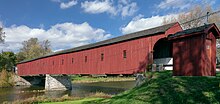


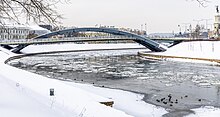
The simplest and earliest types of bridges werestepping stones.
Neolithicpeople also built a form ofboardwalkacrossmarshes;examples of such bridges include theSweet Trackand thePost Trackin England, approximately 6000 years old.[5]Ancient people would also have usedlog bridges[6]consisting of logs that fell naturally or were intentionally felled or placed across streams. Some of the firsthuman-madebridges with significant span were probably intentionally felled trees.[7]Among the oldesttimber bridgesis theHolzbrücke Rapperswil-Hurdenbridge that crossed upperLake Zürichin Switzerland; prehistoric timber pilings discovered to the west of theSeedammcauseway date back to1523 BC.The first wooden footbridge there led across Lake Zürich; it was reconstructed several times through the late2nd century AD,when theRoman Empirebuilt a 6-metre-wide (20 ft) wooden bridge to carry transport across the lake. Between 1358 and 1360,Rudolf IV, Duke of Austria,built a 'new' wooden bridge across the lake that was used until 1878; it was approximately 1,450 metres (4,760 ft) long and 4 metres (13 ft) wide. On April 6, 2001, a reconstruction of the original wooden footbridge was opened; it is also the longest wooden bridge in Switzerland.
TheArkadiko Bridgeis one of four Mycenaeancorbel archbridges part of a former network of roads, designed to accommodatechariots,between the fort of Tiryns and town of Epidauros in thePeloponnese,in southernGreece.Dating to the GreekBronze Age(13th century BC), it is one of the oldestarch bridgesstill in existence and use. Several intact,arched stone bridges from theHellenistic eracan be found in the Peloponnese.[8]
The greatest bridge builders of antiquity were theancient Romans.[9]The Romans built arch bridges andaqueductsthat could stand in conditions that would damage or destroy earlier designs. Some stand today.[10]An example is theAlcántara Bridge,built over the riverTagus,inSpain.The Romans also usedcement,which reduced the variation of strength found in natural stone.[11]One type of cement, calledpozzolana,consisted of water,lime,sand, andvolcanic rock.Brickandmortarbridges were built after theRoman era,as the technology for cement was lost (then later rediscovered).
InIndia,theArthashastratreatise byKautilyamentions the construction of dams and bridges.[12]AMauryanbridge nearGirnarwas surveyed byJames Princep.[13]The bridge was swept away during a flood, and later repaired by Puspagupta, the chief architect of emperorChandragupta I.[13]The use of stronger bridges using plaited bamboo and iron chain was visible in India by about the 4th century.[14]A number of bridges, both for military and commercial purposes, were constructed by theMughaladministration in India.[15]
Although large bridges of wooden construction existed inChinaat the time of theWarring States period,the oldest surviving stone bridge in China is theZhaozhou Bridge,built from 595 to 605 AD during theSui dynasty.This bridge is also historically significant as it is the world's oldestopen-spandrelstone segmental arch bridge. European segmental arch bridges date back to at least theAlconétar Bridge(approximately 2nd century AD), while the enormous Roman eraTrajan's Bridge(105 AD) featured open-spandrel segmental arches in wooden construction.[16]
Rope bridges,a simple type ofsuspension bridge,were used by theIncacivilization in theAndesmountains of South America, just prior to European colonization in the 16th century.
TheAshantibuilt bridges overstreamsandrivers.[17][18]They were constructed by pounding four large forked tree trunks into the stream bed, placing beams along these forked pillars, then positioning cross-beams that were finally covered with four to six inches of dirt.[18]
During the 18th century, there were many innovations in the design of timber bridges byHans Ulrich Grubenmann,Johannes Grubenmann,as well as others. The first book on bridge engineering was written byHubert Gautierin 1716.
A major breakthrough in bridge technology came with the erection ofthe Iron Bridgein Shropshire,Englandin1779.It usedcast ironfor the first time as arches to cross theriver Severn.[19]With theIndustrial Revolutionin the 19th century,trusssystems ofwrought ironwere developed for larger bridges, but iron does not have thetensile strengthto support large loads. With the advent of steel, which has a high tensile strength, much larger bridges were built, many using the ideas ofGustave Eiffel.[20]
InCanadaand theUnited States,numerous timbercovered bridgeswere built in the late 1700s to the late 1800s, reminiscent of earlier designs inGermanyandSwitzerland.Some covered bridges were also built in Asia.[21]In later years, some were partly made of stone or metal but the trusses were usually still made of wood; in theUnited States,there were three styles of trusses, the Queen Post, the Burr Arch and the Town Lattice.[22]Hundreds of these structures still stand in North America. They were brought to the attention of the general public in the1990sby the novel, movie and playThe Bridges of Madison County.[23][24]
In 1927,weldingpioneerStefan Bryładesigned the first weldedroad bridgein the world, theMaurzyce Bridgewhich was later built across the riverSłudwiaat Maurzyce nearŁowicz,Poland in 1929. In 1995, theAmerican Welding Societypresented the Historic Welded Structure Award for the bridge to Poland.[25]
Types of bridges[edit]
Bridges can be categorized in several different ways. Common categories include the type of structural elements used, by what they carry, whether they are fixed or movable, and by the materials used.
Structure types[edit]
Bridges may be classified by how the actions oftension,compression,bending,torsionandshearare distributed through their structure. Most bridges will employ all of these to some degree, but only a few will predominate. The separation of forces and moments may be quite clear. In asuspensionorcable-stayed bridge,the elements in tension are distinct in shape and placement. In other cases the forces may be distributed among a large number of members, as in a truss.
 Beam bridge Beam bridge
|
Beam bridgesare horizontal beams supported at each end by substructure units and can be eithersimply supportedwhen the beams only connect across a single span, orcontinuouswhen the beams are connected across two or more spans. When there are multiple spans, the intermediate supports are known aspiers.The earliest beam bridges were simple logs that sat across streams and similar simple structures. In modern times, beam bridges can range from small, wooden beams to large, steel boxes. The vertical force on the bridge becomes ashearandflexuralload on the beam which is transferred down its length to the substructures on either side[26]They are typically made of steel, concrete or wood.Girder bridgesandplate girder bridges,usually made from steel, are types of beam bridges.Box girder bridges,made from steel, concrete, or both, are also beam bridges. Beam bridge spans rarely exceed 250 feet (76 m) long, as the flexural stresses increase proportionally to the square of the length (and deflection increases proportionally to the 4th power of the length).[27]However, the main span of theRio–Niteroi Bridge,a box girder bridge, is 300 metres (980 ft).[citation needed]
The world's longest beam bridge isLake Pontchartrain Causewayin southernLouisianain the United States, at 23.83 miles (38.35 km), with individual spans of 56 feet (17 m).[28]Beam bridges are the simplest and oldest type of bridge in use today,[29]and are a popular type.[30] |
 Truss bridge Truss bridge
|
Atruss bridgeis a bridge whose load-bearing superstructure is composed of a truss. This truss is a structure of connected elements forming triangular units. The connected elements (typically straight) may be stressed from tension, compression, or sometimes both in response to dynamic loads. Truss bridges are one of the oldest types of modern bridges. The basic types of truss bridges shown in this article have simple designs which could be easily analyzed by nineteenth and early twentieth-century engineers. A truss bridge is economical to construct owing to its efficient use of materials. |
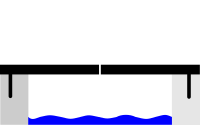 Cantilever bridge Cantilever bridge
|
Cantilever bridgesare built usingcantilevers—horizontal beams supported on only one end. Most cantilever bridges use a pair ofcontinuous spansthat extend from opposite sides of the supporting piers to meet at the center of the obstacle the bridge crosses. Cantilever bridges are constructed using much the same materials and techniques as beam bridges. The difference comes in the action of the forces through the bridge.
Some cantilever bridges also have a smaller beam connecting the two cantilevers, for extra strength. The largest cantilever bridge is the 549-metre (1,801 ft)Quebec Bridgein Quebec, Canada. |
 Arch bridge Arch bridge
|
Arch bridgeshaveabutmentsat each end. The weight of the bridge is thrust into theabutmentsat either side. The earliest known arch bridges were built by the Greeks, and include theArkadiko Bridge.
With the span of 220 metres (720 ft), theSolkan Bridgeover theSočaRiver atSolkanin Slovenia is the second-largest stone bridge in the world and the longest railroad stone bridge. It was completed in 1905. Its arch, which was constructed from over 5,000 tonnes (4,900 long tons; 5,500 short tons) of stone blocks in just 18 days, is the second-largest stone arch in the world, surpassed only by the Friedensbrücke (Syratalviadukt) inPlauen,and the largest railroad stone arch. The arch of the Friedensbrücke, which was built in the same year, has the span of 90 m (295 ft) and crosses the valley of theSyrabachRiver. The difference between the two is that the Solkan Bridge was built from stone blocks, whereas the Friedensbrücke was built from a mixture of crushed stone and cement mortar.[31] The world's largest arch bridge is theChaotianmen Bridgeover theYangtze Riverwith a length of 1,741 m (5,712 ft) and a span of 552 m (1,811 ft). The bridge was opened April 29, 2009, inChongqing,China.[32] |
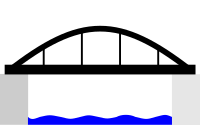 Tied arch bridge Tied arch bridge
|
Tied-arch bridgeshave an arch-shaped superstructure, but differ from conventional arch bridges. Instead of transferring the weight of the bridge and traffic loads into thrust forces into the abutments, the ends of the arches are restrained by tension in the bottom chord of the structure. They are also called bowstring arches. |
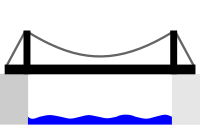 Suspension bridge Suspension bridge
|
Suspension bridgesare suspended from cables. The earliest suspension bridges were made of ropes or vines covered with pieces of bamboo. In modern bridges, the cables hang from towers that are attached to caissons or cofferdams. The caissons or cofferdams are implanted deep into the bed of the lake, river or sea. Sub-types include thesimple suspension bridge,thestressed ribbon bridge,theunderspanned suspension bridge,thesuspended-deck suspension bridge,and theself-anchored suspension bridge.There is also what is sometimes called a "semi-suspension" bridge, of which theFerry Bridgein Burton-upon-Trent is the only one of its kind in Europe.[33]
The longest suspension bridge in the world is the 4,608 m (15,118 ft)1915 Çanakkale Bridgein Turkey. |
 Cable-stayed bridge Cable-stayed bridge
|
Cable-stayed bridges,like suspension bridges, are held up by cables. However, in a cable-stayed bridge, less cable is required and the towers holding the cables are proportionately higher.[34]The first known cable-stayed bridge was designed in 1784 by C. T. (or C. J.) Löscher.[35][36]
The longest cable-stayed bridge since 2012 is the 1,104 m (3,622 ft)Russky BridgeinVladivostok,Russia.[37] |
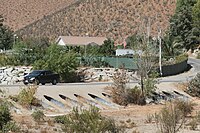 Ford bridge Ford bridge
|
A ford bridge is designed to allow the flow of water over the way. |
Some Engineers sub-divide 'beam' bridges into slab, beam-and-slab and box girder on the basis of their cross-section.[38]A slab can be solid orvoided(though this is no longer favored for inspectability reasons) while beam-and-slab consists of concrete or steel girders connected by a concrete slab.[39]Abox-girdercross-section consists of a single-cell or multi-cellular box. In recent years,integral bridgeconstruction has also become popular.
Fixed or movable bridges[edit]
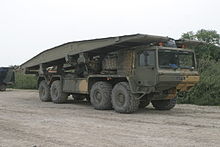
Most bridges are fixed bridges, meaning they have no moving parts and stay in one place until they fail or are demolished. Temporary bridges, such asBailey bridges,are designed to be assembled, taken apart, transported to a different site, and re-used. They are important in military engineering and are also used to carry traffic while an old bridge is being rebuilt.Movable bridgesare designed to move out of the way of boats or other kinds of traffic, which would otherwise be too tall to fit. These are generally electrically powered.[40]
The Tank bridge transporter (TBT) has the same cross-country performance as a tank even when fully loaded. It can deploy, drop off and load bridges independently, but it cannot recover them.[citation needed]
Double-decked bridges[edit]

Double-decked (or double-decker) bridges have two levels, such as theGeorge Washington Bridge,connectingNew York CitytoBergen County,New Jersey,US, as the world's busiest bridge, carrying 102 million vehicles annually;[41][42]trusswork between the roadway levels provided stiffness to the roadways and reduced movement of the upper level when the lower level was installed three decades after the upper level. TheTsing Ma BridgeandKap Shui Mun BridgeinHong Konghave six lanes on their upper decks, and on their lower decks there are two lanes and a pair of tracks forMTRmetro trains. Some double-decked bridges only use one level for street traffic; theWashington Avenue BridgeinMinneapolisreserves its lower level for automobile and light rail traffic and its upper level for pedestrian and bicycle traffic (predominantly students at theUniversity of Minnesota). Likewise, inToronto,thePrince Edward Viaducthas five lanes of motor traffic, bicycle lanes, and sidewalks on its upper deck; and a pair of tracks for theBloor–Danforthsubway lineon its lower deck. The western span of theSan Francisco–Oakland Bay Bridgealso has two levels.
Robert Stephenson'sHigh Level Bridgeacross theRiver TyneinNewcastle upon Tyne,completed in 1849, is an early example of a double-decked bridge. The upper level carries a railway, and the lower level is used for road traffic. Other examples includeBritannia Bridgeover theMenai StraitandCraigavon BridgeinDerry,Northern Ireland.TheOresund BridgebetweenCopenhagenandMalmöconsists of a four-lane highway on the upper level and a pair of railway tracks at the lower level.Tower Bridgein London is different example of a double-decked bridge, with the central section consisting of a low-levelbascule spanand a high-levelfootbridge.
Viaducts[edit]
A viaduct is made up of multiple bridges connected into one longer structure. The longest and some of the highest bridges are viaducts, such as theLake Pontchartrain CausewayandMillau Viaduct.
Multi-way bridge[edit]
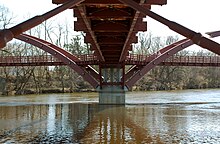
A multi-way bridge has three or more separate spans which meet near the center of the bridge. Multi-way bridges with only three spans appear as a "T" or "Y" when viewed from above. Multi-way bridges are extremely rare.The Tridge,Margaret Bridge,andZanesville Y-Bridgeare examples.
Bridge types by use[edit]
A bridge can be categorized by what it is designed to carry, such as trains, pedestrian or road traffic (road bridge), a pipeline (Pipe bridge) or waterway for water transport or barge traffic. Anaqueductis a bridge that carries water, resembling a viaduct, which is a bridge that connects points of equal height. A road-rail bridge carries both road and rail traffic. Overway is a term for a bridge that separates incompatible intersecting traffic, especially road and rail.[43]A bridge can carry overhead power lines as does theStorstrøm Bridge.[citation needed]
Some bridges accommodate other purposes, such as the tower ofNový MostBridge inBratislava,which features a restaurant, or abridge-restaurantwhich is a bridge built to serve as a restaurant. Other suspension bridge towers carry transmission antennas.[44]
Conservationists usewildlife overpassesto reducehabitat fragmentationand animal-vehicle collisions.[45]The firstanimal bridgessprung up in France in the 1950s, and these types of bridges are now used worldwide to protect both large and small wildlife.[46][47][48]
Bridges are subject to unplanned uses as well. The areas underneath some bridges have become makeshift shelters and homes to homeless people, and the undertimbers of bridges all around the world are spots of prevalent graffiti. Some bridges attract people attemptingsuicide,and become known assuicide bridges.[49][50]
Bridge types by material[edit]
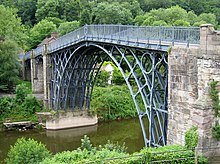

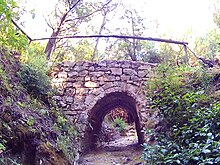
The materials used to build the structure are also used to categorize bridges. Until the end of the 18th century, bridges were made out of timber, stone and masonry. Modern bridges are currently built in concrete, steel, fiber reinforced polymers (FRP), stainless steel or combinations of those materials.Living bridgeshave been constructed of live plants such asFicus elasticatree roots in India[51]andwisteriavines in Japan.[52]
| Bridge type | Materials used |
|---|---|
| Cantilever | For small footbridges, the cantilevers may be simple beams; however, large cantilever bridges designed to handle road or rail traffic use trusses built fromstructural steel,or box girders built fromprestressed concrete.[53] |
| Suspension | The cables are usually made ofsteel cablesgalvanised withzinc,[citation needed]along with most of the bridge, but some bridges are still made with steel-reinforced concrete.[54] |
| Arch | Stone,brickand other such materials that are strong in compression and somewhat so in shear. |
| Beam | Beam bridges can use pre-stressed concrete, an inexpensive building material, which is then embedded withrebar.The resulting bridge can resist both compression and tension forces.[55] |
| Truss | The triangular pieces of truss bridges are manufactured from straight and steel bars, according to the truss bridge designs.[56] |
Analysis and design[edit]
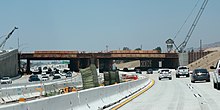
Unlike buildings whose design is led by architects, bridges are usually designed by engineers. This follows from the importance of the engineering requirements; namely spanning the obstacle and having the durability to survive, with minimal maintenance, in an aggressive outdoor environment.[39]Bridges are first analysed; the bending moment and shear force distributions are calculated due to the applied loads. For this, thefinite element methodis the most popular. The analysis can be one-, two-, or three-dimensional. For the majority of bridges, a two-dimensional plate model (often with stiffening beams) is sufficient or an upstand finite element model.[57]On completion of the analysis, the bridge is designed to resist the applied bending moments and shear forces, section sizes are selected with sufficient capacity to resist the stresses. Many bridges are made ofprestressed concretewhich has good durability properties, either by pre-tensioning of beams prior to installation or post-tensioning on site.
In most countries, bridges, like other structures, are designed according toLoad and Resistance Factor Design(LRFD) principles. In simple terms, this means that the load is factored up by a factor greater than unity, while the resistance or capacity of the structure is factored down, by a factor less than unity. The effect of the factored load (stress, bending moment) should be less than the factored resistance to that effect. Both of these factors allow for uncertainty and are greater when the uncertainty is greater.
Aesthetics[edit]

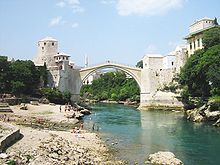
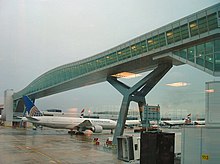
Most bridges are utilitarian in appearance, but in some cases, the appearance of the bridge can have great importance.[58]Often, this is the case with a large bridge that serves as an entrance to a city, or crosses over a main harbor entrance. These are sometimes known as signature bridges. Designers of bridges in parks and along parkways often place more importance on aesthetics, as well. Examples include the stone-faced bridges along theTaconic State Parkwayin New York.
Bridges are typically more aesthetically pleasing if they are simple in shape, the deck is thinner in proportion to its span, the lines of the structure are continuous, and the shapes of the structural elements reflect the forces acting on them.[59]To create a beautiful image, some bridges are built much taller than necessary. This type, often found in east-Asian style gardens, is called aMoon bridge,evoking a rising full moon. Other garden bridges may cross only a dry bed of stream-washed pebbles, intended only to convey an impression of a stream. Often in palaces, a bridge will be built over an artificial waterway as symbolic of a passage to an important place or state of mind. A set of five bridges cross a sinuous waterway in an important courtyard of theForbidden CityinBeijing,China.The central bridge was reserved exclusively for the use of the Emperor and Empress, with their attendants.
Bridge maintenance[edit]

The estimated life of bridges varies between 25 and 80 years depending on location and material.[60][61]
Bridges may age hundred years with proper maintenance and rehabilitation. Bridge maintenance consisting of a combination of structural health monitoring and testing. This is regulated in country-specific engineer standards and includes an ongoing monitoring every three to six months, a simple test or inspection every two to three years and a major inspection every six to ten years. In Europe, the cost of maintenance is considerable[38]and is higher in some countries than spending on new bridges. The lifetime of welded steel bridges can be significantly extended byaftertreatment of the weld transitions.This results in a potential high benefit, using existing bridges far beyond the planned lifetime.
Bridge traffic loading[edit]
While the response of a bridge to the applied loading is well understood, the applied traffic loading itself is still the subject of research.[62]This is a statistical problem as loading is highly variable, particularly for road bridges. Load Effects in bridges (stresses, bending moments) are designed for using the principles ofLoad and Resistance Factor Design.Before factoring to allow for uncertainty, the load effect is generally considered to be the maximum characteristic value in a specifiedreturn period.Notably, in Europe, it is the maximum value expected in 1000 years.
Bridge standards generally include a load model, deemed to represent the characteristic maximum load to be expected in the return period. In the past, these load models were agreed by standard drafting committees of experts but today, this situation is changing. It is now possible to measure the components of bridge traffic load, to weigh trucks, usingweigh-in-motion(WIM) technologies. With extensive WIM databases, it is possible to calculate the maximum expected load effect in the specified return period. This is an active area of research, addressing issues of opposing direction lanes,[63][64]side-by-side (same direction) lanes,[65][66]traffic growth,[67]permit/non-permit vehicles[68]and long-span bridges (see below). Rather than repeat this complex process every time a bridge is to be designed, standards authorities specify simplified notional load models, notably HL-93,[69][70]intended to give the same load effects as the characteristic maximum values. TheEurocodeis an example of a standard for bridge traffic loading that was developed in this way.[71]
Traffic loading on long span bridges[edit]
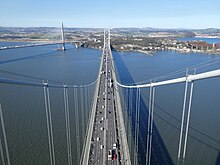
Most bridge standards are only applicable for short and medium spans[72]- for example, the Eurocode is only applicable for loaded lengths up to 200 m. Longer spans are dealt with on a case-by-case basis. It is generally accepted that the intensity of load reduces as span increases because the probability of many trucks being closely spaced and extremely heavy reduces as the number of trucks involved increases. It is also generally assumed that short spans are governed by a small number of trucks traveling at high speed, with an allowance for dynamics. Longer spans on the other hand, are governed by congested traffic and no allowance for dynamics is needed.
Calculating the loading due to congested traffic remains a challenge as there is a paucity of data on inter-vehicle gaps, both within-lane and inter-lane, in congested conditions.Weigh-in-Motion(WIM) systems provide data on inter-vehicle gaps but only operate well in free flowing traffic conditions. Some authors have used cameras to measure gaps and vehicle lengths in jammed situations and have inferred weights from lengths using WIM data.[73]Others have usedmicrosimulationto generate typical clusters of vehicles on the bridge.[74][75][76]
Bridge vibration[edit]
Bridges vibrate under load and this contributes, to a greater or lesser extent, to the stresses.[39]Vibration and dynamics are generally more significant for slender structures such as pedestrian bridges and long-span road or rail bridges. One of the most famous examples is theTacoma Narrows Bridgethat collapsed shortly after being constructed due to excessive vibration. More recently, theMillennium Bridgein London vibrated excessively under pedestrian loading and was closed and retrofitted with a system of dampers. For smaller bridges, dynamics is not catastrophic but can contribute an added amplification to the stresses due to static effects. For example, the Eurocode for bridge loading specifies amplifications of between 10% and 70%, depending on the span, the number of traffic lanes and the type of stress (bending moment or shear force).[77]
Vehicle-bridge dynamic interaction[edit]
There have been many studies of the dynamic interaction between vehicles and bridges duringvehiclecrossing events. Fryba[78]did pioneering work on the interaction of a moving load and an Euler-Bernoulli beam. With increased computing power, vehicle-bridge interaction (VBI) models have become ever more sophisticated.[79][80][81][82]The concern is that one of the many natural frequencies associated with the vehicle will resonate with the bridge's first natural frequency.[83]The vehicle-related frequencies include body bounce and axle hop but there are also pseudo-frequencies associated with the vehicle's speed of crossing[84]and there are many frequencies associated with the surface profile.[62]Given the wide variety of heavy vehicles on road bridges, a statistical approach has been suggested, with VBI analyses carried out for many statically extreme loading events.[85]
Bridge failures[edit]
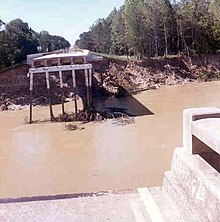
The failure of bridges is of special concern forstructural engineersin trying to learn lessons vital to bridge design, construction and maintenance.
The failure of bridges first assumed national interest in Britain during theVictorian erawhen many new designs were being built, often using new materials, with some of them failing catastrophically.
In the United States, theNational Bridge Inventorytracks the structural evaluations of all bridges, including designations such as "structurally deficient" and "functionally obsolete".
Bridge health monitoring[edit]
There are several methods used to monitor the condition of large structures, like bridges. Many long-span bridges are now routinely monitored with a range of sensors, including strain transducers,accelerometers,[86]tiltmeters, and GPS. Accelerometers have the advantage that they are inertial, i.e., they do not require a reference point to measure from. This is often a problem for distance or deflection measurement, especially if the bridge is over water.[87]Crowdsourcingbridge conditions by accessing data passively captured bycell phones,which routinely include accelerometers and GPS sensors, has been suggested as an alternative to including sensors during bridge construction and an augment for professional examinations.[88]
An option for structural-integrity monitoring is "non-contact monitoring", which uses theDoppler effect(Doppler shift). Alaserbeam from aLaser Doppler Vibrometeris directed at the point of interest, and the vibration amplitude and frequency are extracted from the Doppler shift of the laser beam frequency due to the motion of the surface.[89]The advantage of this method is that the setup time for the equipment is faster and, unlike an accelerometer, this makes measurements possible on multiple structures in as short a time as possible. Additionally, this method can measure specific points on a bridge that might be difficult to access. However, vibrometers are relatively expensive and have the disadvantage that a reference point is needed to measure from.
Snapshots in time of the external condition of a bridge can be recorded usingLidarto aid bridge inspection.[90]This can provide measurement of the bridge geometry (to facilitate the building of a computer model) but the accuracy is generally insufficient to measure bridge deflections under load.
While larger modern bridges are routinely monitored electronically, smaller bridges are generally inspected visually by trained inspectors. There is considerable research interest in the challenge of smaller bridges as they are often remote and do not have electrical power on site. Possible solutions are the installation of sensors on a specialist inspection vehicle and the use of its measurements as it drives over the bridge to infer information about the bridge condition.[91][92][93]These vehicles can be equipped with accelerometers, gyrometers, Laser Doppler Vibrometers[94][95]and some even have the capability to apply a resonant force to the road surface in order to dynamically excite the bridge at its resonant frequency.
Visual index[edit]
See also[edit]
- Air draft
- Architectural engineering
- Bridge chapel
- Bridge tower
- Bridge to nowhere
- Bridges Act
- BS 5400
- Causeway
- Coal trestle
- Covered bridges
- Cross-sea traffic ways
- Culvert
- Deck
- Devil's Bridge
- Footbridge
- Jet bridge
- Landscape architecture
- Megaproject
- Military bridges
- Orphan bridge
- Outline of bridges
- Overpass
- Pier (bridge structure)
- Pontoon bridge
- Rigid-frame bridge
- Structure gauge
- Transporter bridge
- Tensegrity
- Trestle bridge
- Tunnel
References[edit]
- ^Fowler (1925).The Concise Oxford Dictionary.Oxford University Press. p. 102.
- ^abPearsall, Judy, ed. (2001)."bridge".The Concise Oxford Dictionary(10th ed.). Oxford University Press. p. 173.ISBN0-19-860438-6.RetrievedDecember 27,2022.(Full text via theInternet Archive.)(registration required)
- ^"Bridge: Etymology".
- ^"South Eighth Street Viaduct, Spanning Little Lehigh Creek at Eighth Street (State Route 2055), Allentown, Lehigh County, PA (HAER No. PA-459)".Historic American Engineering Record.RetrievedJanuary 11,2021.
- ^Brunning, Richard (February 2001). "The Somerset Levels".Current Archaeology.XV (4) (172 (Special issue on Wetlands)): 139–143.
- ^National Parks Conference, Department of the Interior (1915).Proceedings of the National parks conference held at Berkeley, California March 11, 12, and 13, 1915.Washington, DC:Government Printing Office.p.60.RetrievedMarch 14,2010– via Internet Archive.
(A log bridge) is a bridge composed of log beams, the logs being in natural condition orhewn,which are thrown across twoabutments,and over which traffic may pass.
- ^Bennett, David (2000)."The history and aesthetic development of bridges".In Ryall, M.J.; Parke, G.A.R.; Harding, J.E. (eds.).The manual of bridge engineering.London: Thomas Telford. p. 1.ISBN978-0-7277-2774-9.RetrievedMarch 14,2010– via Google books.
- ^Kutz, Myer (2011).Handbook of Transportation Engineering, Volume II: Applications and Technologies, Second Edition.McGraw-Hill Professional.ISBN978-0-07-161477-1.
- ^DeLony, Eric (1996)."Context for World Heritage Bridges".Icomos.org. Archived fromthe originalon February 21, 2005.
- ^"History of Bridges".Historyworld.net.Archivedfrom the original on January 6, 2012.RetrievedJanuary 4,2012.
- ^"Lessons from Roman Cement and Concrete".Pubs.asce.org. Archived fromthe originalon February 10, 2005.RetrievedJanuary 4,2012.
- ^Dikshitar, V.R.R. Dikshitar (1993).The Mauryan Polity,Motilal Banarsidass, p. 332ISBN81-208-1023-6.
- ^abDutt, Romesh Chunder (2000).A History of Civilisation in Ancient India: Vol II,Routledge, p. 46,ISBN0-415-23188-4.
- ^"suspension bridge" inEncyclopædia Britannica(2008). 2008 Encyclopædia Britannica, Inc.
- ^Nath, R. (1982).History of Mughal Architecture,Abhinav Publications, p. 213,ISBN81-7017-159-8.
- ^Bjelić, Igor (2022)."Use of Building Materials During the Construction of Trajan's Bridge on the Danube".Arheologija I Prirodne Nauke.18:45–58.doi:10.18485/arhe_apn.2022.18.4.ISSN1452-7448.
- ^Ivor Wilks(1989).Asante in the Nineteenth Century: The Structure and Evolution of a Political Order.CUP Archive. p. 38.ISBN9780521379946.RetrievedDecember 29,2020– via Books.google.
- ^abEdgerton, Robert B. (2010).The Fall of the Asante Empire: The Hundred-Year War For Africa's Gold Coast.Simon and Schuster. p. 62.ISBN9781451603736.
- ^"Iron Bridge".Engineering Timelines.Archivedfrom the original on March 4, 2016.RetrievedNovember 18,2016.
- ^"Gustave Eiffel-15 Iconic Projects".RTF | Rethinking The Future.June 20, 2020.RetrievedJune 12,2021.
- ^"Historic Wooden Bridges/" Covered Bridges "".HSNB.DE. July 11, 2011. Archived fromthe originalon March 4, 2016.RetrievedOctober 15,2018.
- ^"Hidden Masterpieces: Covered Bridges in PA".Pennsylvania Book Center. Spring 2010.RetrievedOctober 15,2018.
- ^"Throwback Thursday: Covered bridges".Canadian Geographic.May 28, 2015.RetrievedOctober 15,2018.
- ^"Visit America's Most Idyllic Covered Bridges".Architectural Digest.December 2016.RetrievedOctober 15,2018.
- ^Sapp, Mark E. (February 22, 2008)."Welding Timeline 1900–1950".WeldingHistory.org. Archived fromthe originalon August 3, 2008.RetrievedApril 29,2008.
- ^"Beam bridges".Design Technology.Archivedfrom the original on May 18, 2008.RetrievedMay 14,2008.
- ^Structural Beam Deflection Stress Bending Equations / Calculation Supported on Both Ends Uniform LoadingArchivedJanuary 22, 2013, atarchive.today.Engineers Edge.Retrieved on April 23, 2013.
- ^"A big prefabricated bridge".Life.Vol. 40, no. 22. May 28, 1956. pp. 53–60.
- ^"ASCE | Civil What? | Bridges".asceville.org.Archivedfrom the original on February 3, 2017.RetrievedFebruary 2,2017.
- ^Naito, Clay; Sause, Richard; Hodgson, Ian; Pessiki, Stephen; Macioce, Thomas (2010). "Forensic Examination of a Noncomposite Adjacent Precast Prestressed Concrete Box Beam Bridge".Journal of Bridge Engineering.15(4): 408–418.doi:10.1061/(ASCE)BE.1943-5592.0000110.
- ^Gorazd Humar (September 2001)."World Famous Arch Bridges in Slovenia".In Charles Abdunur (ed.).Arch'01: troisième Conférence internationale sur les ponts en arc Paris(in English and French). Paris: Presses des Ponts. pp. 121–124.ISBN2-85978-347-4.Archivedfrom the original on July 30, 2016.
- ^"Longest bridge, steel arch bridge".Guinness World Records. Archived fromthe originalon October 19, 2013.RetrievedFebruary 18,2013.
- ^A.O.P. Guide to Burton-on-Trent,1911, p. 13[full citation needed]
- ^Johnson, Andy."Cable Stay vs Suspension Bridges".U.S. Department of Energy.Archivedfrom the original on May 18, 2008.
- ^Walther, René (1999).Cable Stayed Bridges.Thomas Telford. p. 7.ISBN978-0-7277-2773-2.Archivedfrom the original on November 15, 2016.
- ^Poser, Marcel."Cable Stayed Structures and Stay Cable Technology"(PDF).Archived fromthe original(PDF)on February 9, 2013.
- ^Elder, Miriam (July 2, 2012)."Russian city of Vladivostok unveils record-breaking suspension bridge".The Guardian.London.Archivedfrom the original on January 20, 2016.RetrievedFebruary 3,2016.
- ^abŽnidarič, Aleš; Pakrashi, Vikram; O'Brien, Eugene; O'Connor, Alan (December 2011). "A review of road structure data in six European countries".Proceedings of the Institution of Civil Engineers - Urban Design and Planning.164(4): 225–232.doi:10.1680/udap.900054.hdl:10197/4877.ISSN1755-0793.S2CID110344262.
- ^abcO'Brien, Eugene J.; Keogh, Damien L.; O'Connor, Alan J. (October 6, 2014).Bridge deck analysis(Second ed.). Boca Raton: CRC Press.ISBN9781482227246.OCLC892094185.
- ^Hovey, Otis Ellis (1927).Movable bridges.New York: John Wiley & Sons, Inc. pp. 1–2.hdl:2027/mdp.39015068174518.
- ^ab"Port Authority of New York and New Jersey – George Washington Bridge".The Port Authority of New York and New Jersey.Archivedfrom the original on September 20, 2013.RetrievedFebruary 14,2023.
- ^Bod Woodruff; Lana Zak & Stephanie Wash (November 20, 2012)."GW Bridge Painters: Dangerous Job on Top of the World's Busiest Bridge".ABC News.Archivedfrom the original on September 28, 2013.RetrievedSeptember 13,2013.
- ^"The Mile-End Crossing".The Observer.Vol. LXXXI, no. 6, 004. South Australia. February 23, 1924. p. 16.RetrievedMarch 26,2018– via National Library of Australia.
- ^Roberts, Gethin; Brown, Christopher; Tang, Xu; Ogundipe, Oluporo (February 2015)."Using satellites to monitor Severn Bridge structure, UK".Proceedings of the ICE - Bridge Engineering.168(4): 330–339.doi:10.1680/bren.14.00008.
- ^Greenfield, Patrick (January 23, 2021)."How creating wildlife crossings can help reindeer, bears – and even crabs".The Guardian.Archivedfrom the original on January 23, 2021.RetrievedJanuary 26,2021.
- ^Sarah Holder (July 31, 2018)."Animals Need Infrastructure Too".Bloomberg.RetrievedFebruary 21,2019.
- ^Jessica Stewart (February 9, 2017)."Bridges for Animals to Safely Cross Freeways Are Popping Up Around the World".My Modern Met.RetrievedFebruary 21,2019.
- ^Rachel Newer (July 23, 2012)."World's Coolest Animal Bridges".Smithsonian.RetrievedFebruary 21,2019.
- ^Glasgow, Garrett (March 1, 2011)."Do local landmark bridges increase the suicide rate? An alternative test of the likely effect of means restriction at suicide-jumping sites".Social Science & Medicine.72(6): 884–889.doi:10.1016/j.socscimed.2011.01.001.ISSN0277-9536.PMID21320739.
- ^Marsh, Julia (December 30, 2018)."Port Authority not liable for NYC bridge jumpers: judge".New York Post.RetrievedJanuary 3,2019.
- ^"How are Living Root Bridges Made?".The Living Root Bridge Project.May 5, 2017.Archivedfrom the original on September 5, 2017.RetrievedSeptember 8,2017.
- ^"The Vine Bridges of Iya Valley".Atlas Obscura.Archivedfrom the original on September 8, 2017.RetrievedSeptember 8,2017.
- ^"Cantilever".Bridges of Dublin.Archivedfrom the original on October 29, 2014.
- ^"Suspension Bridges".Made How.Archivedfrom the original on January 2, 2015.
- ^"Beam Bridges".Nova Online.PBS.Archivedfrom the original on January 6, 2015.
- ^K, Aggeliki; Stonecypher, Lamar (February 10, 2010)."Truss Bridge Designs".Bright Hub Engineering.Archivedfrom the original on February 19, 2015.
- ^O'Brien, E.J; Keogh, D.L (December 1998). "Upstand finite element analysis of slab bridges".Computers & Structures.69(6): 671–683.doi:10.1016/S0045-7949(98)00148-5.hdl:10197/4054.
- ^Leonhardt, Fritz (1984).Bruc̈ken: Asthetik und Gestaltung[Bridges: aesthetics and design]. Cambridge, MA: MIT Press.ISBN0262121050.OCLC10821288.
- ^"Bridge Aesthetics. Design guideline to improve the appearance of bridges in NSW"(PDF).February 2009. Archived fromthe original(PDF)on October 9, 2022.
- ^Estes, Allen C.; Frangopol, Dan M. (December 1, 2001)."Bridge Lifetime System Reliability under Multiple Limit States".Journal of Bridge Engineering.6(6): 523–528.doi:10.1061/(ASCE)1084-0702(2001)6:6(523).ISSN1084-0702.
- ^Ford, K.; Arman, M.; Labi, S.; Sinha, K.C.; Thompson, P.D.; Shirole, A.M.; Li, Z. (2012).Estimating life expectancies of highway assets.Washington, DC: Transportation Research Board, National Academy of Sciences. NCHRP Report 713.
- ^abOBrien, Eugene J.; Keogh, Damien L.; O'Connor, Alan (2015).Bridge deck analysis.CRC Press.ISBN9781482227239.OCLC897489682.
- ^Enright, Bernard; O'Brien, Eugene J. (December 2013). "Monte Carlo simulation of extreme traffic loading on short and medium span bridges".Structure and Infrastructure Engineering.9(12): 1267–1282.Bibcode:2013SIEng...9.1267E.doi:10.1080/15732479.2012.688753.hdl:10197/4868.ISSN1573-2479.S2CID10042252.
- ^Caprani, Colin C.; OBrien, Eugene J. (March 2010). "The use of predictive likelihood to estimate the distribution of extreme bridge traffic load effect".Structural Safety.32(2): 138–144.doi:10.1016/j.strusafe.2009.09.001.hdl:10197/2329.S2CID44049002.
- ^OBrien, Eugene J.; Enright, Bernard (July 2011)."Modeling same-direction two-lane traffic for bridge loading".Structural Safety.33(4–5): 296–304.doi:10.1016/j.strusafe.2011.04.004.hdl:10197/3062.S2CID53475878.
- ^OBrien, Eugene J.; Leahy, Cathal; Enright, Bernard; Caprani, Colin C. (September 30, 2016)."Validation of scenario modelling for bridge loading".The Baltic Journal of Road and Bridge Engineering.11(3): 233–241.doi:10.3846/bjrbe.2016.27.hdl:10197/9252.ISSN1822-427X.
- ^OBrien, E.J.; Bordallo-Ruiz, A.; Enright, B. (September 2014). "Lifetime maximum load effects on short-span bridges subject to growing traffic volumes".Structural Safety.50:113–122.doi:10.1016/j.strusafe.2014.05.005.hdl:10197/7069.S2CID59945573.
- ^Enright, Bernard; OBrien, Eugene J.; Leahy, Cathal (December 2016). "Identifying and modelling permit trucks for bridge loading".Proceedings of the Institution of Civil Engineers - Bridge Engineering.169(4): 235–244.doi:10.1680/bren.14.00031.hdl:10197/9246.ISSN1478-4637.
- ^"HL-93 AASHTO Vehicular Live Loading | Truck | Tandem | Design Lane Load".EngineeringCivil.org.August 17, 2016.RetrievedMarch 15,2019.
- ^Leahy, Cathal; OBrien, Eugene J.; Enright, Bernard; Hajializadeh, Donya (October 2015). "Review of HL-93 Bridge Traffic Load Model Using an Extensive WIM Database".Journal of Bridge Engineering.20(10): 04014115.doi:10.1061/(ASCE)BE.1943-5592.0000729.hdl:10197/7068.ISSN1084-0702.S2CID53503763.
- ^O'Connor, Alan; Jacob, Bernard; O'Brien, Eugène; Prat, Michel (June 2001). "Report of Current Studies Performed on Normal Load Model of EC1: Part 2. Traffic Loads on Bridges".Revue Française de Génie Civil.5(4): 411–433.doi:10.1080/12795119.2001.9692315.hdl:10197/4024.ISSN1279-5119.S2CID111112374.
- ^A.S, Nowak; M, Lutomirska; F.I, Sheikh Ibrahim (2010). "The development of live load for long span bridges".Bridge Structures.6(1, 2): 73–79.doi:10.3233/BRS-2010-006.ISSN1573-2487.
- ^Micu, Elena Alexandra; Obrien, Eugene John; Malekjafarian, Abdollah; Quilligan, Michael (December 21, 2018)."Estimation of Extreme Load Effects on Long-Span Bridges Using Traffic Image Data".The Baltic Journal of Road and Bridge Engineering.13(4): 429–446.doi:10.7250/bjrbe.2018-13.427.hdl:10344/7494.ISSN1822-4288.
- ^OBrien, E. J.; Hayrapetova, A.; Walsh, C. (March 2012). "The use of micro-simulation for congested traffic load modeling of medium- and long-span bridges".Structure and Infrastructure Engineering.8(3): 269–276.Bibcode:2012SIEng...8..269O.doi:10.1080/15732471003640477.hdl:10197/3061.ISSN1573-2479.S2CID54812838.
- ^Caprani, Colin C.; OBrien, Eugene J.; Lipari, Alessandro (May 2016). "Long-span bridge traffic loading based on multi-lane traffic micro-simulation".Engineering Structures.115:207–219.Bibcode:2016EngSt.115..207C.doi:10.1016/j.engstruct.2016.01.045.
- ^OBrien, Eugene J.; Lipari, Alessandro; Caprani, Colin C. (July 2015). "Micro-simulation of single-lane traffic to identify critical loading conditions for long-span bridges".Engineering Structures.94:137–148.Bibcode:2015EngSt..94..137O.doi:10.1016/j.engstruct.2015.02.019.hdl:10197/6998.S2CID56030686.
- ^Dawe, Peter (2003).Research perspectives: traffic loading on highway bridges.London: Thomas Telford.ISBN0727732412.OCLC53389159.
- ^Fryba, L. (2009).Dynamics of railway bridges.Thomas Telford.ISBN9780727739568.OCLC608572498.
- ^Li, Yingyan; OBrien, Eugene; González, Arturo (May 2006). "The development of a dynamic amplification estimator for bridges with good road profiles".Journal of Sound and Vibration.293(1–2): 125–137.Bibcode:2006JSV...293..125L.doi:10.1016/j.jsv.2005.09.015.hdl:10197/2529.S2CID53678242.
- ^Cantero, D.; González, A.; OBrien, E. J. (June 2009). "Maximum dynamic stress on bridges traversed by moving loads".Proceedings of the Institution of Civil Engineers - Bridge Engineering.162(2): 75–85.doi:10.1680/bren.2009.162.2.75.hdl:10197/2553.ISSN1478-4637.S2CID53057484.
- ^Cantero, D; O'Brien, E J; González, A (June 2010). "Modelling the vehicle in vehicle—infrastructure dynamic interaction studies".Proceedings of the Institution of Mechanical Engineers, Part K: Journal of Multi-Body Dynamics.224(2): 243–248.doi:10.1243/14644193JMBD228.hdl:10197/2551.ISSN1464-4193.S2CID59583241.
- ^González, A.; Cantero, D.; OBrien, E.J. (December 2011). "Dynamic increment for shear force due to heavy vehicles crossing a highway bridge".Computers & Structures.89(23–24): 2261–2272.doi:10.1016/j pstruc.2011.08.009.hdl:10197/3426.S2CID53367765.
- ^González, Arturo; OBrien, Eugene J.; Cantero, Daniel; Li, Yingyan; Dowling, Jason; Žnidarič, Ales (May 2010). "Critical speed for the dynamics of truck events on bridges with a smooth road surface".Journal of Sound and Vibration.329(11): 2127–2146.Bibcode:2010JSV...329.2127G.doi:10.1016/j.jsv.2010.01.002.hdl:10197/2138.S2CID56078933.
- ^Brady Sean P.; O'Brien Eugene J.; Žnidarič Aleš (March 1, 2006). "Effect of Vehicle Velocity on the Dynamic Amplification of a Vehicle Crossing a Simply Supported Bridge".Journal of Bridge Engineering.11(2): 241–249.doi:10.1061/(ASCE)1084-0702(2006)11:2(241).hdl:10197/2327.S2CID53417698.
- ^OBrien, Eugene J.; Cantero, Daniel; Enright, Bernard; González, Arturo (December 2010)."Characteristic Dynamic Increment for extreme traffic loading events on short and medium span highway bridges".Engineering Structures.32(12): 3827–3835.Bibcode:2010EngSt..32.3827O.doi:10.1016/j.engstruct.2010.08.018.hdl:10197/4045.S2CID52250745.
- ^"The new Minnesota smart bridge"(PDF).mnme.Archived fromthe original(PDF)on August 23, 2012.RetrievedJanuary 30,2012.
- ^Bagher Shemirani, Alireza (2022),"Experimental and numerical studies of concrete bridge decks using ultra high-performance concrete and reinforced concrete",Computers and Concrete,29(6),doi:10.12989/cac.2022.29.6.407
- ^Riordon, James R. (December 3, 2022). "Cell phones track bridge integrity".Science News(Paper). Vol. 202, no. 10. p. 8.
- ^"Basic Principles of Vibrometry".polytec.Archivedfrom the original on June 10, 2012.RetrievedJanuary 25,2012.
- ^Omer; et al. (2018)."Performance evaluation of bridges using virtual reality".Proceedings of the 6th European Conference on Computational Mechanics (ECCM 6) & 7th European Conference on Computational Fluid Dynamics (ECFD 7), Glasgow, Scotland.
- ^Yang, Y.-B.; Lin, C.W.; Yau, J.D. (May 2004). "Extracting bridge frequencies from the dynamic response of a passing vehicle".Journal of Sound and Vibration.272(3–5): 471–493.Bibcode:2004JSV...272..471Y.doi:10.1016/S0022-460X(03)00378-X.
- ^Yang, Y. B.; Yang, Judy P. (February 2018). "State-of-the-Art Review on Modal Identification and Damage Detection of Bridges by Moving Test Vehicles".International Journal of Structural Stability and Dynamics.18(2): 1850025.doi:10.1142/S0219455418500256.ISSN0219-4554.
- ^Malekjafarian, Abdollah; McGetrick, Patrick J.; OBrien, Eugene J. (2015)."A Review of Indirect Bridge Monitoring Using Passing Vehicles".Shock and Vibration.2015:1–16.doi:10.1155/2015/286139.hdl:10197/7054.ISSN1070-9622.
- ^OBrien, E. J.; Keenahan, J. (May 2015). "Drive-by damage detection in bridges using the apparent profile".Structural Control and Health Monitoring.22(5): 813–825.doi:10.1002/stc.1721.hdl:10197/7053.S2CID55735216.
- ^Malekjafarian, Abdollah; Martinez, Daniel; OBrien, Eugene J. (2018)."The Feasibility of Using Laser Doppler Vibrometer Measurements from a Passing Vehicle for Bridge Damage Detection".Shock and Vibration.2018:1–10.doi:10.1155/2018/9385171.hdl:10197/9539.ISSN1070-9622.
Further reading[edit]
- Shemirani, Alireza Bagher (June 25, 2022)."Experimental and numerical studies of concrete bridge decks using ultra high-performance concrete and reinforced concrete".Computers and Concrete.29(6): 407–418.doi:10.12989/CAC.2022.29.6.407.
- Brown, David J. (2005).Bridges: three thousand years of defying nature.Buffalo, NY: Firefly Books.ISBN978-1-55407-099-2.</ref>
- Sandak, Cass R. (December 31, 1983).Bridges.Franklin Watts.ISBN978-0-531-04624-1.
- Whitney, Charles S.Bridges of the World: Their Design and Construction.Mineola, NY: Dover Publications, 2003.ISBN0-486-42995-4(Unabridged republication ofBridges: a study in their art, science, and evolution.1929.)
External links[edit]
- Digital Bridge: Bridges of the Nineteenth CenturyArchivedAugust 26, 2005, at theWayback Machine,a collection of digitized books at Lehigh University
- Structurae– International Database and Gallery of Engineerings Structures with over 10000 Bridges.
- U.S. Federal Highway Administration Bridge Technology
- The Museum of Japanese Timber BridgesArchivedJune 23, 2011, at theWayback MachineFukuoka University
- "bridge-info.org": site for bridges

